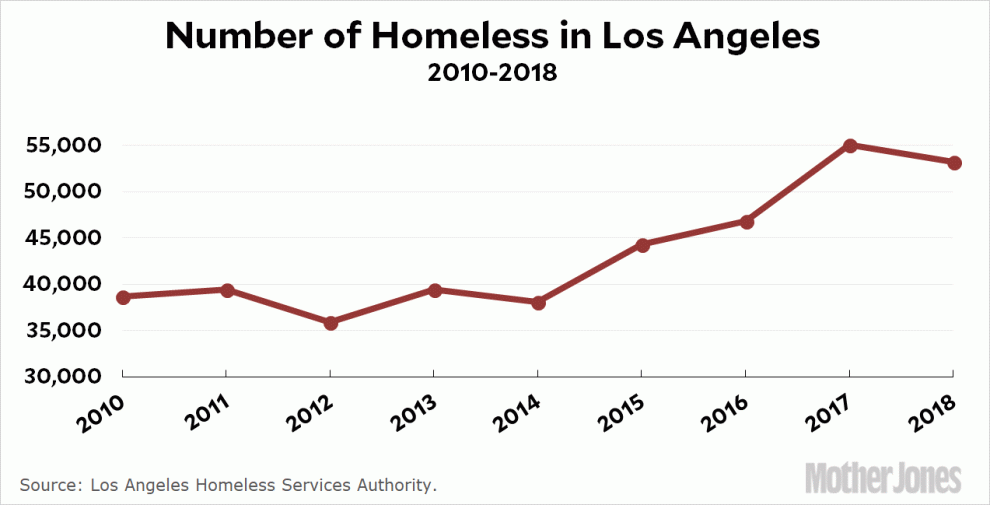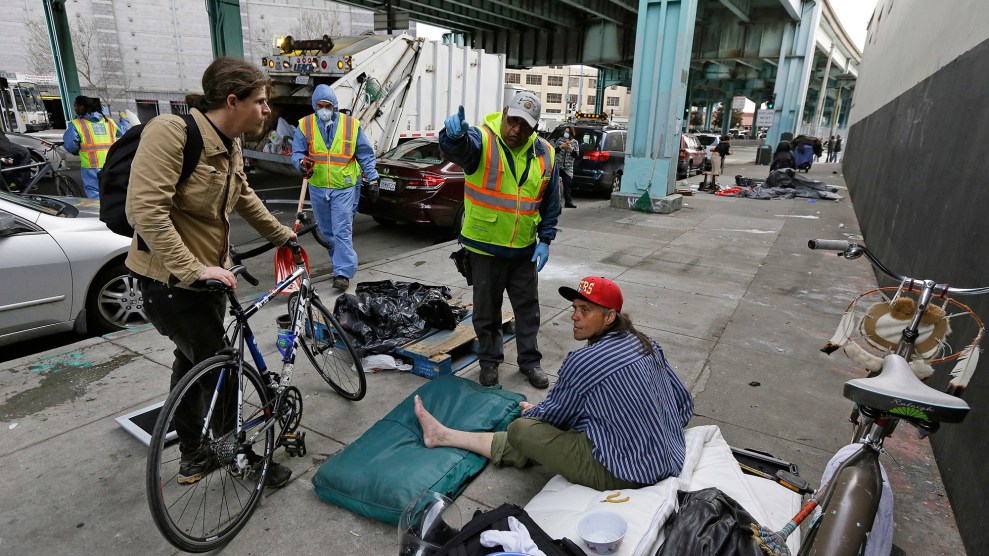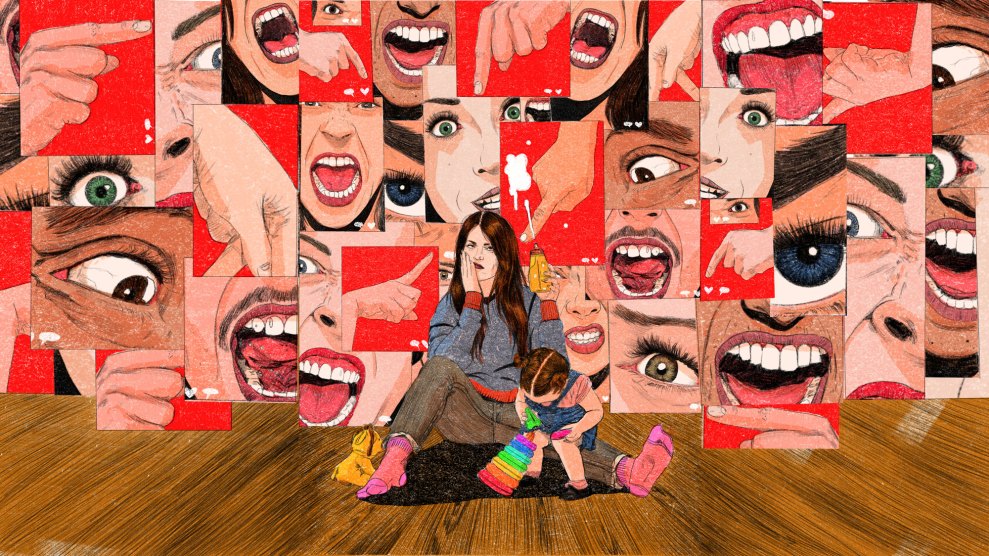The last time audiences saw actor Emilio Estevez in a library was in 1985 for a dance sequence in the brat pack classic The Breakfast Club.
Thirty-four years later in his new movie, The Public, Estevez is playing the librarian, caught in the middle of a police standoff with library patrons, most of whom are homeless, during a life-threatening cold snap in Cincinnati. Estevez wrote, produced, and directed the feel-good drama, which came out in limited release on April 5, also starring Alec Baldwin and Gabrielle Union.
Mother Jones editor-in-chief Clara Jeffery sat down with Estevez earlier this month during a special screening at Laemmle Music Hall in Los Angeles to spotlight the issues of homelessness. He was joined by Joel Roberts, CEO of People Assisting the Homeless, a nonprofit in Los Angeles that helps low-income and homeless people find a place to live, and Ryan Dowd, executive director of Hesed House, a homeless shelter in Aurora, Illinois, and author of The Librarian’s Guide to Homelessness.
Listen to a short excerpt of the interview at the end of this week’s episode of the Mother Jones Podcast below, or read on for an edited version of the conversation:
Clara Jeffery: The last time moviegoers saw you in a library, you were vaulting through the stacks at Shermer High. I have one semi-frivolous question, which is, what did you think of Alexandria Ocasio-Cortez’s rendition of The Breakfast Club dancing?
Emilio Estevez: She definitely has moves. I thought it was cool. I don’t think it’s something she should have been punished for. It’s something she should have been celebrated for and she was.
CJ: What compelled you to make a movie about the homeless in a library?
EE: This began 12 years ago, on April 1, 2007. The LA Times landed on my door, and I opened it up and there was an article by a retiring Salt Lake City librarian named Chip Ward called Written Off. It was later published online under another title, What They Didn’t Teach Us In Library School on Tom Dispatch.
It was essentially about how libraries have become de facto homeless shelters and how librarians have become de facto social workers and first responders. He said this was not isolated to Salt Lake, but happening in every library across the country. I was moved by the piece. I went back down to the downtown branch of the LA public library and started digging back into library world, and it was, in fact, every bit the crisis that he described. So, I began to imagine a story of what would it look like if the patrons on a particularly cold night decided not to leave. How would the media spin it? How would politicians spin it? How would law enforcement react? And that was the beginning of it. A year later I had an unwieldy 155-page monster script but nevertheless, we got some funding for it. I was casting, putting a crew together. And then the economic crisis hit. We lost our funding. And in many ways, I’m grateful because I think the film is far more relevant now than it would have been if we made it 10 years ago.
CJ: How did events that transpired between the first script and cast influence this version of the film?
EE: There was a big shift. It went from a very diabolical, very dark ending to one that was an ending that celebrates nonviolent civil disobedience. I had to think about how I was going to physically disarm the police. Then I thought, no better way than to fully expose ourselves, because what better way to disarm a fellow human being with a weapon than to present yourself in all of your glory and let your freak flag fly?
CJ: Your last film, The Way, was about an existential crisis or a crisis of faith, and this is really more about a larger societal breakdown. Do you see those two things as being related?
EE: I’m interested in films that explore our humanity and in movies that are about people. I make movies about things that I know about: the human condition, how we relate to each other, and the intersectionality of all of us in this moment in time. That is what The Way was about, that’s what Bobby was about, and certainly that’s what this picture is about.
CJ: Now, Ryan and Joel, you both run homeless NGOs. And Ryan you’ve written a book about how the homeless avail themselves to the library. I’m wondering, besides seeking shelter, what is it about the library that draws homeless people to it?
Ryan Dowd: Libraries are everything that homeless shelters are not. They’re not as crowded, not as loud. I run a homeless shelter, but they’re not a great place to be, particularly if you’re struggling with autism or mental health issues. So libraries can be a refuge from the chaos of homelessness. It’s not just the heat, it’s not just the fact you can charge your cellphone there—but an opportunity to get away from homelessness for a little while.
CJ: There’s a question I’ve always wondered about: When homeless people are suffering from mental illness, is that the likely cause of why they ended up on the street, or is ending up on the street causing people to have mental breakdowns? I mean, it’s so traumatic.
Joel Roberts: All kinds of people end up being homeless—from a woman who’s fleeing domestic violence, to veterans, to people struggling with alcoholism or drugs or mental health issues. But frankly, if I were living on the streets, it would really freak me out, and I might turn to alcohol to self-medicate or just to survive. The reality is people are going to libraries because there’s nothing else out there. And for the last 20 or 30 years, we have not built the infrastructure of housing to get these people off the streets. As we know here in Los Angeles, they’re living in the parks, they’re living in vehicles, and they’re going anywhere they can, including libraries, and it’s just a sad state of our society today.
CJ: Ryan, in Chicago, is there a “must shelter” or a right-to-shelter rule?
RD: No.
CJ: So even in a place as cold as Chicago, there’s no mandate to provide shelter?
RD: No. But Chicago did a fairly good job when the polar vortexes made it hit negative-60 windchill about a month ago, and everybody mobilized. But other than that…
JR: In New York City, if you are homeless you have a right to shelter. So the city actually has to have enough shelter beds for every single person on the streets. We don’t have that here in Los Angeles.
RD: New York state, Massachusetts, and DC are the only three that have right to shelter laws.
CJ: Emilio, you’ve been going to cities all over the country. Are you seeing cities embrace a housing-first philosophy?
EE: We were just in Salt Lake City last week, and it has pretty much eliminated chronic homelessness by providing housing. But again, this is an epidemic. Every urban area in the country is experiencing it. And to your point, it is about housing first. I don’t think you could have a conversation even about universal health care until you get a roof over somebody’s head because when you start looking at the emergency assistance to treat somebody who is on the street in Los Angeles, it costs $68,000 a year to take care of a person. That’s emergency room visits, police response. You put a roof over that same person’s head and it goes down to $15,000 a year. So we’re all paying that number, whether it’s 68 or 15. We all do better when we all do better. We’ve got to get to universal housing to be able to tap into universal health care because you can’t get well if you’re on the street.
CJ: Here comes my shameless plug: We actually did a big feature story on the housing-first policy in Salt Lake City and also in Santa Clara County, and if you guys are interested in learning more about it, you can find that online at MotherJones.com. Here in LA, what are the barriers to getting more of that housing? Is the voucher system no longer sufficient?
JR: Obviously, it’s really expensive to buy land and to build or to even rent or own here in LA. So the big barriers are: The cost to build it, the cost to provide services, and for neighborhoods to say, “Yes, in my backyard!”
CJ: Ryan, how have the drivers of homelessness changed over the years? What’s the difference, if any, in the kind of makeup of the population?
RD: When our shelter opened, it was almost exclusively unemployed single males. There were no women, there were no children. First time we had a child in our shelter it made the front page of the newspaper. And now we average 50 kids a night, and 20 percent of the population is female. Seventy-five percent of the population has some sort of income. The demographics are broadening and, not only is it expanding the number of people, but the demographics of who’s affected is broadening dramatically.
CJ: At least in San Francisco, a lot of people assume that because of the weather and San Francisco’s kind of permissiveness, folks come from elsewhere to be homeless in our city. Actually that’s not really true. And I’m wondering, Joel, were most homeless in San Francisco previously housed in San Francisco?
JR: I think that’s the case in most cities. Even Los Angeles, if you’re homeless in Long Beach or Venice, you probably came from Long Beach or Venice because you’re not going to want to be homeless in another neighborhood that you’re not familiar with. It’s the same thing all over the country.
EE: Just working with Ryan for the last year, we talk about the fact that homelessness is a relatively new issue. It’s a new problem. It began when HUD was gutted by 77 percent in 1980. But we’re often asked when we do these Q&As, can it be solved? And I believe it can.
RD: Homelessness absolutely can be solved. If we can create homelessness in 40 years, certainly we can uncreate it in 10, 20, 40 max. But in order for that to happen, we have to be having the right conversations. And I think we have an absolutely fantastic tool to have those right conversations, so thank you, Emilio, for that. But in order to have those conversations and have this tool, we need to get people seeing this movie.
CJ: And by the way, the movie opens in theaters on April 5. So everyone tell your friends to go see it and pay to see it yourselves again. I’ve now seen it twice. It’s even better the second time around. I’m sure you all have experienced, either yourselves or in your fields, the question of how to deal with compassion fatigue. How do we get the public over their compassion fatigue? Do you guys experience that among your workers and volunteers? How do you handle the stress?
JR: I share with our staff that we have to keep our eye on the ball. For us, the ball is moving somebody off the street and into an apartment. And when they move into an apartment, we celebrate with them. We have signs and pictures and everything saying that they made it home, and that’s what keeps us going.
CJ: Emilio, what are some of the biggest misconceptions that you wanted to confront in this movie?
EE: Well, certainly the library is not an antiquated institution. In fact, librarians were the first Google and they are woefully underfunded. Most of the money goes to law enforcement and fire, paramedics, parks and rec. Libraries are ninth or tenth in terms of funding, if you’re lucky. The author Anne Lamott said, “Communities without libraries are like radios without batteries.” So it’s my hope that people will go and rediscover their libraries. Also, that people will check their bias at the door when encountering folks on the street. There’s no other place for any of us to go. We’re all in this together. To solve this problem we’ve got to look to each other and we’ve got to look to ourselves and we have to dig in because it is solvable.
CJ: I would just like each of you to leave us with one thing that you would like us to know about homelessness and what we can do to help mitigate and combat it.
JR: If people are so desperate to look for housing that they’re going to our libraries, our society has a big problem, and the problem is we just don’t have enough housing that’s affordable for everybody.
RD: The thing we can do right now is get this movie out there because this movie does something that Hollywood never gets right. Hollywood usually takes homelessness and informs a caricature of every stereotype or a caricature of the “noble poor person” who’s perfect and blameless and has never done anything wrong and never cusses, and smells perfect. None of that is real, and this movie actually is the first movie in a long, long time that actually captures the humanity of homelessness. So the biggest thing we can do right now is get people out to see this movie.
EE: We talked about “not in my backyard.” I think we all have to sort of step back and say, okay, if not me, then who? If not now, when? And I think we have to find that place in our heart to say, “Yes, you are my brother, you are my sister, and I accept you as my neighbor,” and invite development in your neighborhood, and that is a big giant step because it comes with a lot of unknowns, but isn’t that part of the great mystery of life?













